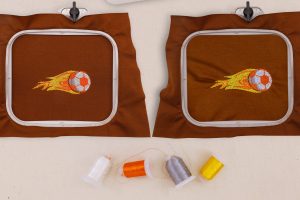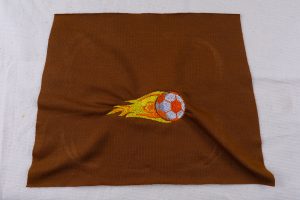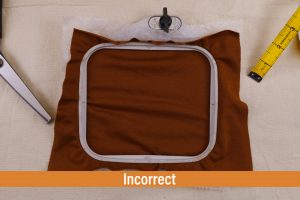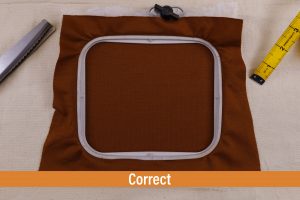Embroiderers are extremely talented and creative, willingly putting in long hours and committed to create embroidery designs. However, every artist has one thing that tests their patience and leaves them frustrated; for embroiderers it is puckering. Embroidery puckering is the biggest fear of an embroiderer, and is considered one of the common problems faced during embroidery, which ends up giving an unprofessional look to the final product.
Factors That Cause Puckering
There could be few reasons which are causing the fabric to pucker. A roundup of the usual suspects include:
High Distortion Design
Usually high impact design with relatively high stitch count results in puckering problems. The fabric pulling action occurs, when the needle and the bobbin threads form stitches thus creating texture in the fabric. In short, pulling and pushing of the fabric results in puckering, and usually when designs have stitches that are going in different directions and angles relative to the fabric.
Stretched Fabric During Hooping
Fabric should be placed in a neutral position in the hoop. If the fabric is loosely hooped or is over stretched, it will cause puckering. The fabric should be smoothly hooped and not stretched or distorted by any means during the embroidery.

Improper Fabric Stabilization
Most items we embroider are stretched to some extent. The more the fabric stretches, the more it is unstable. In such situations, many embroiderers prefer to use stabilizers in order to prevent or overcome the fabric stretch and the subsequent puckering during the embroidery process. Stabilizers are products that are used at the back of the fabric, or on top of the fabric or even applied to the fabric such as starch or temporary spray adhesives. If the fabric stabilization is not proper, puckering occurs frequently and gives an unpleasant look to the embroidery.
Relation Between Thread Tension And Speed
The embroidery machine’s speed plays a vital role in creating and enhancing thread tension on the fabric. The more the needle and bobbin thread tension on the machine, greater will be fabric distortion. In short, speeding up the machine also increases the thread tension.
Polyester Thread Usage
Did you know that polyester fabric stretches to a point that it breaks if tension is applied on it?
During embroidery on a polyester fabric, the machine speed creates tension on the fabric stretching it as a result. Within 24 hours of sewing and removal of the hoop, the fabric shrinks back to its original state. This shrinkage attribute of the polyester fabric causes wrinkles and puckering around the embroidery.
Thread Displacement
A tightly woven fabric has less space for the extra thread of embroidery to fill up, hence there is little or no breathing room between yarns to adjust the embroidery threads and consequently results in wrinkling or puckering. Therefore, it is important to take extra care while selecting the design for embroidery and thread count of the fabric.
Preventative Measures For Puckering
Accurate Position Of The Fabric In The Embroidery Hoop
If the fabric is placed loosely in the hoop, it will easily frizz up under the tension of the stitches. When placing the fabric in an embroidery hoop, make sure it is not too loose to cause wrinkles and not too tight to wrap in the grain of the fabric. Controlling the slippage during the embroidery process is essential for best outcomes.
Selection Of The Correction Fabric
Selecting the right fabric to avoid wrinkle and puckering is necessary for a professional looking product. Every fabric has different characteristic depending on fiber, construction, weave, weight, and finish making them suitable for the embroidery. Have a look on the post about https://crewelghoul.com/blog/best-fabric-for-embroidery/ in order to select the correct fabric that will lead you to running a successful embroidery thread business.
Things That Are Needed To Consider When Choosing The Material To Embroider
Fabric Weave
Fabric Weight
If you are planning to embroider clothing pieces or a fabric that will be washed, do prewash test it just to check its shrinkage. If it drastically shrinks ignore your choice!
Use Of A Stabilizer For Embroidery
Stabilizers are also known as “backing” in industrial circle and are considered essential for machine embroidery. stabilizer supports the fabric during stitching process and prevents the puckering and stretching.
While embroidering on a delicate and stretchy fabric, you must use a stabilizer at the back of the fabric in order to avoid puckering as these fabrics are challenging to work with.What Fabric Are Most Likely To Pucker?
Puckering can occur on any type of fabric for different reasons. Now, lets have a look on the fabric which are prone to puckering frequently:
Slippery fabrics like nylon and satin frequently pucker because they can slide easily around on the stabilizer.
Knit fabrics have great capability of stretching and can easily cause puckering during stitching.
A lightweight textile like linen is another tricky category of fabrics that can easily pucker, because they are so thin and easily bunch up while being embroidered.
How Could I Stop My Puckering Machine Embroidery
During embroidery process, if puckering occurs. first thing you need to do is to stop the embroidery machine and place the tear-away stabilizer underneath your hooped fabric, and then start the machine again to resume stitching. Embroiderers use an extra layer of stabilizer at an industrial level of embroidery! After the project is completed, puckering is usually minimized to some extent with a good ironing.
If you come across problems of puckering after embroidery, then in such situation either you have to loosen the stitches or completely take them out. Sometimes, by losing certain stitches using seam ripple fabric can tear the fabric. So careful actions are required to avoid such mishaps of wear and tear.Conclusion
Keep in mind that puckering can occur on any design or fabric type during stitching. Very dense designs and small letters are worst offenders of puckering! The speed of embroidery machine can help you out to a certain extent, in avoiding puckering during stitching process.




